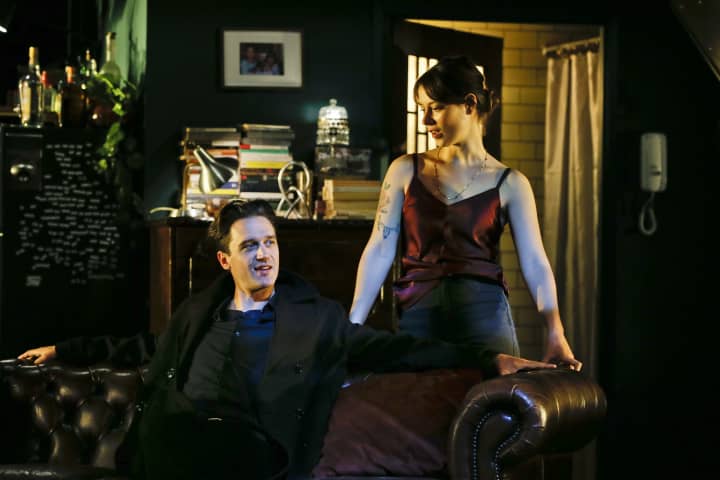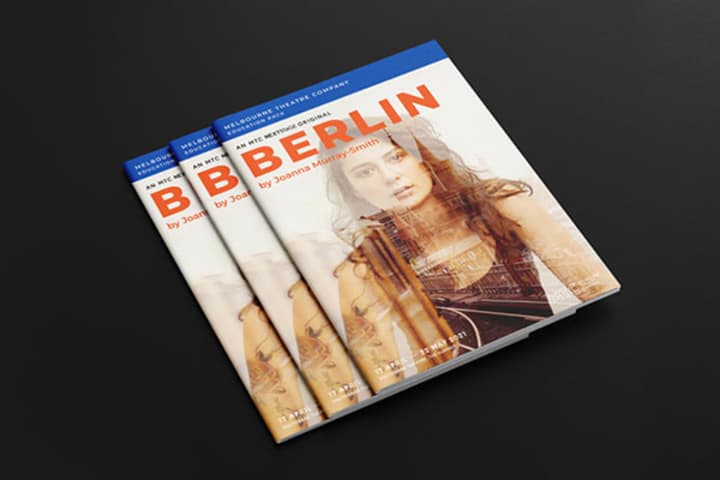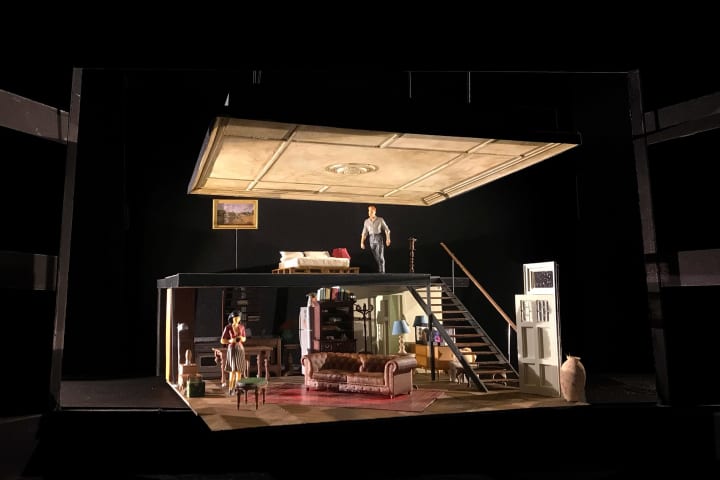Christina Smith has worked on set and costume designs for countless MTC shows. Reuniting with the creative team from A View from the Bridge for the world premiere season of Berlin, she was exhilarated by the uncharted territory of being one of the first people to explore this new Joanna Murray-Smith play.
What were your impressions when you first read the Berlin script?
I think one of my initial reactions to Berlin, one of the really obvious elements of the script, was time – the idea that it happened over the scope of one night. I found the structure of it really striking, and intriguing. The three scenes have very distinct structures: scene one is a seduction, scene two is post-seduction but still in the dead of night, and in scene three it’s been written with this idea of the cold light of day. So there was this understanding that the space would need to transform over those three scenes, and be revealed in the end; that I would have a lot of dark corners, and they would actually come to be revealed.
The other thing is that it’s set in the one apartment, so there was an obvious response that the space would be very contained, firstly in a beautiful and intimate way for scene one, but it almost ends up feeling like you’re trapped in there by scene three.
What inspirations immediately jumped out to you in terms of set design?
In terms of inspiration, that probably came more after having an initial chat with the director, Iain Sinclair. I always aim to read the text before the first meeting, but I work very hard to not form any concrete visual opinions [until I talk with the director]. I want to come in being very plastic and malleable, but still with an understanding of the text and understanding of what the text means to me.
So after that initial chat with Iain, we talked a lot about the idea of context and the idea of memory. We spoke about the idea that even though this particular play is set in a contemporary time, there’s a past and a history that the characters can’t escape. We also talked about the idea of what it’s like to have a relationship built on those pieces of history, so there was an immediate thought that this space needed to have fragments of that history within it, and it needed to be a fragmented space, not a complete space – that was a very strong initial idea. Around the time I was doing this design, there was a Cornelia Parker exhibition in Sydney that I ended up going up to see. She has a very famous work, Cold Dark Matter: An Exploded View, which is literally an exploded garden shed. It’s amazing! So that idea of these fragments sort of floating in space provided a lot of resonance.
And in terms of early visual imagery, we also talked a lot about the idea of this piece being almost like a thriller, so I turned to film noir imagery, with the dark long shadows and an air of mystery. We looked at imagery from the film The Third Man, for instance, because the space needed to have some mystery to it.

Grace Cummings and Michael Wahr, channelling film noir in Berlin. Photo Jeff Busby
Where did your design research begin for this production?
I’m stealing a phrase from a colleague here, who always tells me to research like a spider. It’s the idea that all these different arms or legs of research branch out from the central text, so I’m usually looking into many different areas at once. There’s a whole arm of research into contemporary Berlin apartments, and apartments in older buildings, looking at the architecture of the area and how people were living in old buildings. I was trying to find the resonances with the idea of wartime Berlin, and maybe even pre-war Berlin. We knew there had to be a sense of history, because the play is built on this idea of not being able to escape history.
I’ve mentioned Cornelia Parker, but another artist that resonated with me was Gordon Matta-Clark, who also worked with fragmenting houses, exploding houses. So to sum up, there was new Berlin, old Berlin, wartime Berlin, shattering, fragments – all of those different arms were researched at the same time and in the end the design sort of popped out of them, I guess.
Is this set ultimately based on a real place or is it from your imagination – or both?
It’s based on many, many different places. I’ve always found it really difficult to base any design on just one thing, whether it be a costume or a location or a scenery. It always seems to be the product of many different influences and this one’s no exception. I think probably the biggest instigator was looking at the images of old apartments. Joanna talks in the text about old Berlin and the Clärchens Ballhaus. The wonderful thing about that building is that its interiors have this fabulous sense of decay. It’s got these fabulous walls that are sort of peeling history.
‘All those fragments, all the bits of history from the 20th century, were going to be held within this sandwich of history with the old ceiling and the old floor, and then all of the decades held within.’
So there was this idea of the sandwich of history. Knowing that this space wasn’t going to have walls and that it was going to be a fragmented and elemental set, I thought it had to be a sandwich: all those fragments, all the bits of history from the 20th century, were going to be held within this sandwich of history with the old ceiling and the old floor, and then all of the decades held within.
What was the most challenging aspect of this design process?
Deadlines are challenging! I’m always working against the clock in that regard but they are particularly challenging when it comes to brand new work. The part of that process I find very challenging is to lock in a design before we have a final draft of the play. That is a little harrowing, even though doing new work is always exhilarating. It’s uncharted territory, and it’s wonderful to know that you’re the first person exploring the work, but it is harrowing having to lock it in, simply due to logistics, so far before everyone else. Sometimes you can come out of it with a different play by the time it actually gets to be staged, so that’s probably the trickiest bit.
In such cases is there much scope for you to be able to update if you need to?
It’s really tricky and generally speaking it depends on when assets are built. In many cases the set has finished its build before rehearsal has commenced. I’ve never been in the position where I’ve had to rebuild an entire element of the set, but with Berlin by the time we actually got to the rehearsal room, because it had actually been so long since we began the design [due to the COVID lockdowns interrupting the process] we did jettison a few elements. And we repainted a couple of things, so it did actually evolve a little more than maybe it normally would.
And the most fun aspect of the process?
Working with a new text – that is such fun because you are literally the first person exploring it. There is no precedent. And sometimes the most rewarding part of designing is just the conversations you have about the work. Sometimes I pinch myself and go ‘wow, my job is to talk about plays!’
What does the set tell us about Charlotte?
When Iain and I first spoke about Charlotte’s place, we talked about that sense of mystery when you go back to someone’s house for the first time and you’re wandering around having a look at everything, wondering where things came from. All of your possessions tell the story of you, and we wanted there to be anachronistic choices in Charlotte’s place, for that sense of history but also some intrigue. It needed to feel like an assembly of the 20th century; we didn’t want it to be completely from an IKEA catalogue. We also wanted an idea of there also being elements from her family, like maybe she could have inherited some old furniture. And we wanted the old furniture to almost walk a line between ‘have you picked that up on the side of the road, or is it actually valuable?’ That all tells us a bit about her history.
What’s your favourite part of the set and why?
There’s lots of bits about this set that I really like. I think there’s some really tremendous scenic painting on the furniture and the ceiling, and I have a great admiration for the people who did the set construction. It’s one of my favourite floors that I’ve done.
I also really liked the way that Iain has used the set. I confess that I was actually very dubious about the mezzanine level for a long time, and Iain was adamant that we had to have that separation. I eventually came around, and now I love the way in which the set has been utilised, seeing how the different levels come into play both spatially between the two performers and how it almost adds a psychological layer to their relationship – particularly as we go into scene three. I find it quite satisfying that up in the mezzanine they’re so close to that ceiling of history crushing them. I also love how up on the mezzanine it’s almost like a different space. Downstairs, there’s set dressing and there are all the little bits of history to grab your attention, but upstairs it’s a painting and a bed and a ceiling of history about to crush you. The stakes get raised up there, and I like that very much.

Grace Cummings on the mezzanine level of the Berlin set, with and Michael Wahr below. Photo: Jeff Busby
The other thing is the fact that it is out into the auditorium, which is something I don’t get to do very often nowadays because it kills seats. It’s been my ongoing quest in that space to try to move out onto the apron because there is something about the idea of the actor being in the same architectural space as the audience, which is such a different feeling to being behind a proscenium. And because this was a two-hander, Iain in fact had requested it very early on in the discussion; he felt he needed to get past the proscenium with this particular work, that it was the right thing to do for this play: we needed the immediacy of those two with the audience.
What’s an interesting set component that was made for this production (not sourced)?
To be honest, I reused a lot of stock elements in terms of furniture, so there wasn’t that much. It was a very reused show because of that idea of wanting it to look assembled. But interestingly, the bathroom door was a beautifully built door, made from scratch. You can barely see it in the set, and in fact it was in an entirely different location to begin with, as it was our front door, but we jettisoned it in week two. But there was something about the door that I just couldn’t leave alone. So I decided to do a big door swap because I loved it so much!
The most bizarre thing that was made was the bed. It was supposed to be a pallet bed but we couldn’t use a real one because of all the splinters, so a ‘pallet bed’ that looked like something really student-y and thrown together was painstakingly remade. And then when it went into the theatre it had to be padded for the fight choreography. It was supposed to be so improvised and it ended up being probably the most costly!
You have a long history with MTC: what is it about the Company that keeps bringing you back?
The Melbourne Theatre Company is one of the few companies in the state where you do have the resources to be able to really explore a work and explore the space. The fact that the MTC has all of their artisans in house, these incredibly skilled costume makers and props makers and scenic artists and workshop – that’s a really delightful thing, that is sadly becoming rarer and rarer to actually have that in house.
Berlin is on at Southbank Theatre, The Sumner until 22 May. Tickets are on sale now.
Published on 10 May 2021





